Constructing protein polyhedra via orthogonal chemical interactions
- PMID: 31969701
- PMCID: PMC7007351
- DOI: 10.1038/s41586-019-1928-2
Constructing protein polyhedra via orthogonal chemical interactions
Abstract
Many proteins exist naturally as symmetrical homooligomers or homopolymers1. The emergent structural and functional properties of such protein assemblies have inspired extensive efforts in biomolecular design2-5. As synthesized by ribosomes, proteins are inherently asymmetric. Thus, they must acquire multiple surface patches that selectively associate to generate the different symmetry elements needed to form higher-order architectures1,6-a daunting task for protein design. Here we address this problem using an inorganic chemical approach, whereby multiple modes of protein-protein interactions and symmetry are simultaneously achieved by selective, 'one-pot' coordination of soft and hard metal ions. We show that a monomeric protein (protomer) appropriately modified with biologically inspired hydroxamate groups and zinc-binding motifs assembles through concurrent Fe3+ and Zn2+ coordination into discrete dodecameric and hexameric cages. Our cages closely resemble natural polyhedral protein architectures7,8 and are, to our knowledge, unique among designed systems9-13 in that they possess tightly packed shells devoid of large apertures. At the same time, they can assemble and disassemble in response to diverse stimuli, owing to their heterobimetallic construction on minimal interprotein-bonding footprints. With stoichiometries ranging from [2 Fe:9 Zn:6 protomers] to [8 Fe:21 Zn:12 protomers], these protein cages represent some of the compositionally most complex protein assemblies-or inorganic coordination complexes-obtained by design.
Figures
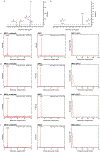
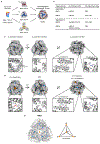


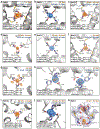

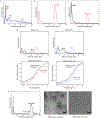
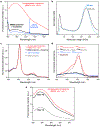

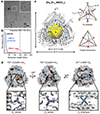


Similar articles
-
Design of metal-mediated protein assemblies via hydroxamic acid functionalities.Nat Protoc. 2021 Jul;16(7):3264-3297. doi: 10.1038/s41596-021-00535-z. Epub 2021 May 28. Nat Protoc. 2021. PMID: 34050338
-
Metal templated design of protein interfaces.Proc Natl Acad Sci U S A. 2010 Feb 2;107(5):1827-32. doi: 10.1073/pnas.0906852107. Epub 2009 Dec 23. Proc Natl Acad Sci U S A. 2010. PMID: 20080561 Free PMC article.
-
Self-assembly of supramolecular architectures and polymers by orthogonal metal complexation and hydrogen-bonding motifs.Chemistry. 2011 Aug 16;17(34):9478-88. doi: 10.1002/chem.201100171. Epub 2011 Jul 5. Chemistry. 2011. PMID: 21732431
-
Functionalization of protein crystals with metal ions, complexes and nanoparticles.Curr Opin Chem Biol. 2018 Apr;43:68-76. doi: 10.1016/j.cbpa.2017.11.015. Epub 2017 Dec 12. Curr Opin Chem Biol. 2018. PMID: 29245143 Review.
-
Polyanionic Imido-P(V) Ligands: From Transition Metal Complexes to Coordination Driven Self-Assemblies.Chem Rec. 2022 Mar;22(3):e202100281. doi: 10.1002/tcr.202100281. Epub 2021 Dec 27. Chem Rec. 2022. PMID: 34962082 Review.
Cited by
-
Connectability of protein cages.Nanoscale Adv. 2020 May 18;2(6):2255-2264. doi: 10.1039/d0na00227e. eCollection 2020 Jun 17. Nanoscale Adv. 2020. PMID: 36133365 Free PMC article. Review.
-
Protein design of two-component tubular assemblies similar to cytoskeletons.Nat Commun. 2025 Jul 22;16(1):6738. doi: 10.1038/s41467-025-62076-3. Nat Commun. 2025. PMID: 40695817 Free PMC article.
-
Computational Design of Single-Peptide Nanocages with Nanoparticle Templating.Molecules. 2022 Feb 12;27(4):1237. doi: 10.3390/molecules27041237. Molecules. 2022. PMID: 35209027 Free PMC article.
-
Microcompartment assembly around multicomponent fluid cargoes.J Chem Phys. 2022 Jun 28;156(24):245104. doi: 10.1063/5.0089556. J Chem Phys. 2022. PMID: 35778087 Free PMC article.
-
Dendrimer-Like Supramolecular Assembly of Proteins with a Tunable Size and Valency Through Stepwise Iterative Growth.Adv Sci (Weinh). 2021 Dec;8(24):e2102991. doi: 10.1002/advs.202102991. Epub 2021 Oct 31. Adv Sci (Weinh). 2021. PMID: 34719882 Free PMC article.
References
-
- Marsh JA & Teichmann SA Structure, Dynamics, Assembly, and Evolution of Protein Complexes. Annu. Rev. Biochem 84, 551–575 (2015). - PubMed
-
- Bai Y, Luo Q & Liu J Protein self-assembly via supramolecular strategies. Chem. Soc. Rev 45, 2756–2767 (2016). - PubMed
-
- Churchfield LA & Tezcan FA Design and Construction of Functional Supramolecular Metalloprotein Assemblies. Acc. Chem. Res 52, 345–355 (2019). - PubMed
Publication types
MeSH terms
Substances
Grants and funding
LinkOut - more resources
Full Text Sources
Research Materials

